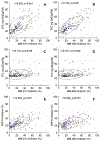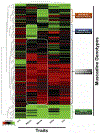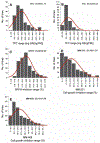The Anticancer and Antioxidant Effects of Muscadine Grape Extracts on Racially Different Triple-negative Breast Cancer Cells
- PMID: 31366486
- PMCID: PMC7754981
- DOI: 10.21873/anticanres.13560
The Anticancer and Antioxidant Effects of Muscadine Grape Extracts on Racially Different Triple-negative Breast Cancer Cells
Abstract
Background/aim: Triple-negative breast cancer (TNBC) is the most aggressive subtype, predominant in African American women. In this study, the antioxidant/anticancer activity of muscadine grape extracts and the role of their phenolic and flavonoid contents in exerting these properties were investigated in TNBC cells.
Materials and methods: Berry extracts from muscadine genotypes were investigated for total phenolic content (TPC), total flavonoid content (TFC), antioxidant capacity, and anticancer effects using breast cancer cell lines, representing Caucasians and African Americans.
Results: The antioxidant activity was associated with high TPC content. Extracts showed cytotoxicity up to 78.6% in Caucasians and 90.7% in African American cells, with an association with high antioxidant capacity. There was a strong correlation between TPC and anticancer/antioxidant activities.
Conclusion: The anticancer and antioxidant effects of muscadine grapes are attributed to the TPC of extracts, which showed a stronger positive correlation with growth inhibition of African American breast cancer cells compared to Caucasians.
Keywords: MDA-MB-231; MDA-MB-468; TNBC; anticancer; antioxidant; flavonoids; phenolic.
Copyright© 2019, International Institute of Anticancer Research (Dr. George J. Delinasios), All rights reserved.
Conflict of interest statement
Conflicts of Interest
The Authors declare that there is no conflict of interest regarding the publication of this paper.
Figures




Similar articles
-
Investigation of Antioxidant and Cytotoxicity Activities of Chocolate Fortified with Muscadine Grape Pomace.Foods. 2023 Aug 22;12(17):3153. doi: 10.3390/foods12173153. Foods. 2023. PMID: 37685084 Free PMC article.
-
In vitro investigation of cytotoxic and antioxidative activities of Ardisia crispa against breast cancer cell lines, MCF-7 and MDA-MB-231.BMC Complement Altern Med. 2018 Mar 12;18(1):87. doi: 10.1186/s12906-018-2153-5. BMC Complement Altern Med. 2018. PMID: 29530022 Free PMC article.
-
Evaluation of phenolic composition, antioxidant, anti-inflammatory and anticancer activities of Polygonatum verticillatum (L.).J Integr Med. 2018 Jul;16(4):273-282. doi: 10.1016/j.joim.2018.04.005. Epub 2018 Apr 18. J Integr Med. 2018. PMID: 29706573
-
The antioxidant, antidiabetic, antimicrobial and anticancer constituents of Artemisia species.Nat Prod Res. 2025 Mar;39(6):1685-1695. doi: 10.1080/14786419.2024.2384082. Epub 2024 Jul 26. Nat Prod Res. 2025. PMID: 39056203 Review.
-
Anticancer and cancer chemopreventive potential of grape seed extract and other grape-based products.J Nutr. 2009 Sep;139(9):1806S-12S. doi: 10.3945/jn.109.106864. Epub 2009 Jul 29. J Nutr. 2009. PMID: 19640973 Free PMC article. Review.
Cited by
-
Synergistic Action of Stilbenes in Muscadine Grape Berry Extract Shows Better Cytotoxic Potential Against Cancer Cells Than Resveratrol Alone.Biomedicines. 2019 Dec 5;7(4):96. doi: 10.3390/biomedicines7040096. Biomedicines. 2019. PMID: 31817440 Free PMC article.
-
The Role of Apoptotic Genes and Protein-Protein Interactions in Triple-negative Breast Cancer.Cancer Genomics Proteomics. 2023 May-Jun;20(3):247-272. doi: 10.21873/cgp.20379. Cancer Genomics Proteomics. 2023. PMID: 37093683 Free PMC article.
-
Evaluation of Biochemical Juice Attributes and Color-Related Traits in Muscadine Grape Population.Foods. 2021 May 16;10(5):1101. doi: 10.3390/foods10051101. Foods. 2021. PMID: 34065684 Free PMC article.
-
Long-read, chromosome-scale assembly of Vitis rotundifolia cv. Carlos and its unique resistance to Xylella fastidiosa subsp. fastidiosa.BMC Genomics. 2023 Jul 20;24(1):409. doi: 10.1186/s12864-023-09514-y. BMC Genomics. 2023. PMID: 37474911 Free PMC article.
-
Investigation of Antioxidant and Cytotoxicity Activities of Chocolate Fortified with Muscadine Grape Pomace.Foods. 2023 Aug 22;12(17):3153. doi: 10.3390/foods12173153. Foods. 2023. PMID: 37685084 Free PMC article.
References
-
- Institute, N.C. Cancer Stat Facts: Female Breast Cancer. 2018. Available from https://seer.cancer.gov/statfacts/html/breast.html.
-
- Carey LA, Perou CM, Livasy CA, Dressler LG, Cowan D, Conway K, Karaca G, Troester MA, Tse CK, Edmiston S, Deming SL, Geradts J, Cheang MC, Nielsen TO, Moorman PG, Earp HS and Millikan RC: Race, breast cancer subtypes, and survival in the Carolina Breast Cancer Study. 295(21): 2492–4502, 2006. DOI: 10.1001/jama.295.21.2492 - DOI - PubMed
MeSH terms
Substances
Grants and funding
LinkOut - more resources
Full Text Sources
Miscellaneous
